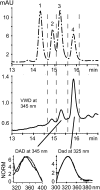Retinoic acid is present in the postnatal rat olfactory organ and persists in vitamin A--depleted neural tissue
- PMID: 19403718
- PMCID: PMC2682984
- DOI: 10.3945/jn.108.096040
Retinoic acid is present in the postnatal rat olfactory organ and persists in vitamin A--depleted neural tissue
Abstract
Vitamin A (VA), all-trans-retinol (at-ROL), and its derivative, all-trans-retinoic acid (at-RA), are required for neuron development. The effects of these retinoids are dependent upon the nutritional status of the rat and tissue-specific dynamics of retinoid access and utilization. The purpose of this study was to determine the status of at-ROL and at-RA in the peripheral olfactory organ of postnatal rats fed a normal diet and rats fed a VA-deficient (VAD) diet. Extracted retinoids were analyzed by HPLC. Resolved sample peaks were identified by comparing their elution times and spectra with those of authentic standards. Mean at-RA and at-ROL concentrations of 23 pmol/g olfactory tissue and 0.13 nmol/g, respectively, were recovered from olfactory tissue. The ratio of at-RA:at-ROL in olfactory was approximately 2 times that in testis and 200 times that in liver. at-ROL was depleted from the liver and olfactory organ of rats fed a VAD diet from birth to 70 d of age. Surprisingly, at-RA was still present in olfactory tissue from these rats. At 90 d of age, the VAD rats were frankly deficient and at-RA was no longer detectable in olfactory tissue. The comparatively high ratio of at-RA:at-ROL in the peripheral olfactory organ and the persistence of at-RA in at-ROL-depleted tissues strongly suggests that maintenance of local stores of at-RA is functionally relevant in this tissue.
Figures


Similar articles
-
Metabolism of a physiological amount of all-trans-retinol in the vitamin A-deficient rat.Arch Biochem Biophys. 2001 Sep 15;393(2):262-70. doi: 10.1006/abbi.2001.2495. Arch Biochem Biophys. 2001. PMID: 11556813
-
Abnormal development of the sinuatrial venous valve and posterior hindbrain may contribute to late fetal resorption of vitamin A-deficient rat embryos.Teratology. 2000 Dec;62(6):374-84. doi: 10.1002/1096-9926(200012)62:6<374::AID-TERA4>3.0.CO;2-5. Teratology. 2000. PMID: 11091359
-
Chronic vitamin A status and acute repletion with retinyl palmitate are determinants of the distribution and catabolism of all-trans-retinoic acid in rats.J Nutr. 2007 Jan;137(1):63-70. doi: 10.1093/jn/137.1.63. J Nutr. 2007. PMID: 17182802 Free PMC article.
-
Retinoid production and catabolism: role of diet in regulating retinol esterification and retinoic Acid oxidation.J Nutr. 2003 Jan;133(1):291S-296S. doi: 10.1093/jn/133.1.291S. J Nutr. 2003. PMID: 12514312 Review.
-
Vitamin A in reproduction and development.Nutrients. 2011 Apr;3(4):385-428. doi: 10.3390/nu3040385. Epub 2011 Mar 29. Nutrients. 2011. PMID: 22254103 Free PMC article. Review.
Cited by
-
Small quantities of carotenoid-rich tropical green leafy vegetables indigenous to Africa maintain vitamin A status in Mongolian gerbils ( Meriones unguiculatus).Br J Nutr. 2010 Jun;103(11):1594-601. doi: 10.1017/S0007114509993588. Epub 2010 Apr 23. Br J Nutr. 2010. PMID: 20412609 Free PMC article.
-
Impaired aldehyde dehydrogenase 1 subfamily member 2A-dependent retinoic acid signaling is related with a mesenchymal-like phenotype and an unfavorable prognosis of head and neck squamous cell carcinoma.Mol Cancer. 2015 Dec 3;14:204. doi: 10.1186/s12943-015-0476-0. Mol Cancer. 2015. PMID: 26634247 Free PMC article.
References
-
- Hyatt GA, Schmitt EA, Marsh-Armstrong N, McCaffery P, Drager UC, Dowling JE. Retinoic acid establishes ventral retinal characteristics. Development. 1996;122:195–204. - PubMed
-
- LaMantia AS, Colbert MC, Linney E. Retinoic acid induction and regional differentiation prefigure olfactory pathway formation in the mammalian forebrain. Neuron. 1993;10:1035–48. - PubMed
-
- Lefebvre PP, Malgrange B, Staecker H, Moonen G, Van de Water TR. Retinoic acid stimulates regeneration of mammalian auditory hair cells. Science. 1993;260:692–5. - PubMed
-
- Luo T, Wagner E, Grun F, Drager UC. Retinoic acid signaling in the brain marks formation of optic projections, maturation of the dorsal telencephalon, and function of limbic sites. J Comp Neurol. 2004;470:297–316. - PubMed
-
- McCaffery P, Drager UC. Regulation of retinoic acid signaling in the embryonic nervous system: a master differentiation factor. Cytokine Growth Factor Rev. 2000;11:233–49. - PubMed
Publication types
MeSH terms
Substances
Grants and funding
LinkOut - more resources
Full Text Sources

